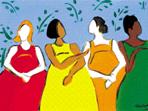
|
|
|
Cultural Link |

Topics of Interest In this IssueBirth Defects Prevention Month Eye Care Month Volunteer Blood Donor Month Healthy Weight Week 21—27 Cultural Competence Self Assessment
National Allied Health Week, 7—13
· · · · · · · National Marrow Awareness Month · National Allied Health Week, 7—13
|
|
JANUARY QUESTION
Birth defects are the leading cause of infant death and childhood disability. The California Birth Defects Monitoring Program has found rates of birth defects vary by racial and ethnic group. Large gaps were also found between US born and foreign born mothers in certain racial/ethnic groups. Which gaps were larger: differences between racial/ethnic groups or differences between US and foreign born women within some ethnic groups?
A prize will be awarded to one person, selected at random, who answers correctly. Email your response to nwosu@etsu.edu by 4:30 pm on January 18. Answer to the December Question: Across countries there is a fairly consistent age grouping of children orphaned by AIDS. About 50% of AIDS orphans are under age 10. AIDS Orphans Congratulations to our December winner.
Did You Know· With the average blood donor being over 50 years of age, Maintaining the blood supply remains challenging. Blood centers must find ways to recruit new donors and provide excellent customer service to retain them. · Mothers’ prenatal reports of alcohol use were found to be more highly correlated with assessment of infants’ cognitive development than were their retrospective postnatal reports of alcohol use. The population was an inner city group of African American mothers. Validity of Maternal Report of Prenatal Alcoholic, and Smoking in Relation to Neurobehavioral Outcome
|
Health Links on Diversity |
|
Article of the Month This study evaluated the correlates of prenatal substance abuse using a nationally representative of pregnant women (N=4185). The proportion of births by mothers from racial/ethnic minorities now comprises 42% of all US live births. In this study, the association of substance abuse in pregnancy was examined by race, ethnicity, and nativity. Unwed mothers were over-sampled in order to determine risk for especially vulnerable populations. Alcohol, tobacco, or illegal substances were consumed by 23% of pregnant women in the study. Foreign born women were less likely to smoke during pregnancy than US born women. The three main findings were: 1. U.S. born and foreign born women (mostly Hispanic) were at equal risk of alcohol use during pregnancy; 2. For all races and ethnicities, maternal substance abuse was most closely associated with paternal substance abuse, 3. women at risk had multiple risk factors (partners with history of substance use, an unwanted pregnancy, previous substance abuse treatment). Planning interventions for prevention of substance abuse during pregnancy requires more research that include larger sub-samples among racial and ethnic groups, including immigrants, as well as risk and protective factors among each group.
assessed annually for three years. The research took an ecological approach simultaneously studying multiple individual, family, and community risk and protective factors focused on occurrence of two types of abuse: severe physical assault and assault of child self-esteem.
|
|
The listing below represents just a few of the resources available to promote knowledge, awareness and discussions on diversity in health care among ETSU students, faculty and staff.
|
TOPIC TITLE & LOCATION |
|
For more information or assistance contact Elaine Evans, Reference Assistant, COM Library,
For more information or assistance contact Elaine Evans, Reference Assistant, COM Library, evanse@etsu.edu. |
|
JANUARY 2007 |

|
New Year Self Assessment: The Youth Leaders Guide to Building Cultural Competence
Examine your own cultural heritage and
|




|
Birth Defects Prevention
Environmental Exposures During Pregnancy–
|
What Alcohol Does to a Child— A longitudinal study of mother-child pairs finds different effects on the cognitive ability of children by race. Read the original article: Moderate Prenatal Alcohol Exposure and Cognitive Status at Age 10 Which of the short screening alcohol use questionnaires work best with prenatal patients? Alcohol-Screening Instruments for Pregnant Women Diabetes disproportionately affects several racial and ethnic minority groups including Hispanics and African Americans, Filipino, Asian Indian, and South & Central American mothers born outside the US. What can happen to the baby of a woman with type 1 or type 2 diabetes during pregnancy? What do you know about Environmental Health Nursing? — Target Area, Health Effects, Source of Hazard, Target Population, Questionnaires. California has one of the best birth defects tracking programs in the country. What are some of the key discoveries found through the California Birth Defects Monitoring Program which tracks birth defects by type, environmental factor, geographic area, maternal characteristics, …. |
|
Eye Care |
Causes and Prevalence of Visual Impairment Among Adults in the US Risk factors differ by disease. An epidemiological study with health interview and clinical exam revealed what types of undiagnosed eye diseases? US Latinos have high rates of eye diseases and visual impairment Do you think you know why people put off having eye exams? Here are some individuals’ stories. Saving your sight—Early detection is critical How much blindness and low vision is preventable with timely, accessible care? Age-related Eye Diseases: An Emerging Challenge for Public Health Professionals
|
|
Healthy Weight
|
How did quality and availability of fresh produce differ in 4 neighborhoods that differed by racial and socioeconomic composition? Fruit and vegetable access differs by community racial composition and socioeconomic position ... How much more expensive was the healthier market basket for a 2-week shopping list than the less healthy market basket? The availability and cost of healthier food alternatives How similar are the barriers to exercise among women of different racial and ethnic groups? Perceived barriers to exercise and stage of exercise adoption in older women of different racial/ethnic groups How serious is the problem of overweight American women? Overweight and Obesity Tables What kinds of weight reduction resources would appeal to different minority populations? Health Power Weight Control Tip Sheet |
|
Volunteer Blood Donors
|
What cultural issues have been found to be associated with reduced volunteer blood donation? Consider some strategies that might reduce the barriers to donation and appeal to different cultural groups? Where have all the donors gone? Blood donors’ average age is over 50 years. Can the Blood Saves Campaign attract younger volunteer blood donors? What other ways might attract racial and ethnic minorities to become volunteer blood donors? Consider other campaigns to recruit volunteer blood donors at Adlibbing |
Other Observances in January |
|
|
New Year’s Day 1 |
Robert Burns’ Night 25 (Scotland) |
|
Christmas (for Coptic & Eastern Orthodox Chuches) 7 |
Greek Education Day 30
|
|
Martin Luther King Day 15 Seijin No Hi (Japan) 15 Celebrates coming of age for 20 year olds
World Religions Day 21 |
Certified Nurse Anesthetist Week 21—27
Activity Professionals Month
Cervical Cancer Screening Month
|
|
|
|
|
Arts, Cultural, and Health Awareness Events |
||
|
1/13 9—5 |
Cosby High School |
|
|
1/13—15 |
Johnson City Venues |
|
|
Campus MLK Celebration & Cake Cutting |
1/16 |
Culp |
|
1/17 noon |
Pan Hellenic Hall, basement |
|
|
1/25 noon |
Pan Hellenic Hall, basement |
|